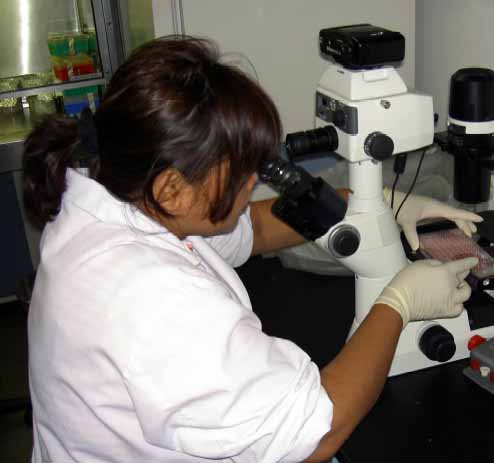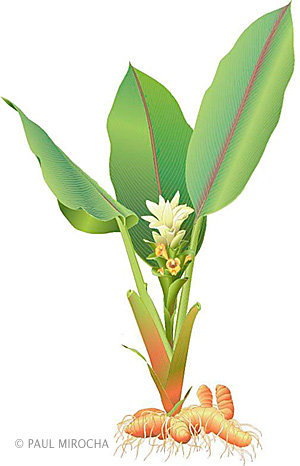Alzheimer
Research Lab
Post graduate Researcher
UCLA Dept Medicine
Curcumin and its metabolite, Aß oligomer, Neuroinflammation, aging

 Dr. Begum is investigating curcumin, a polyphenolic compound from turmeric wh
Dr. Begum is investigating curcumin, a polyphenolic compound from turmeric wh ich, despite putative poor absorption and bioavailabilty, exerted potent anti-Alzheimer’s effects in vivo. Her research on curcumin includes development of methods to assess and improve the bioavailablity and protective activities on Alzheimer’s vulnerable neuroinflammatory genes eg. iNOS, COX-2, quinone reductase. Her studies show that curcumin’s major metabolite tetrahydrocurcumin (THC) has its own activities, some which are similar to curcumin (iNOS inhibition, block Aß-oligomer formation and disaggregation) and some which complement curcumin (since THC is more easily absorbed), but shows that THC does not completely substitute for curcumin’s action (since curcumin better inhibits brain oxidation and more readily penetrates brain). Therefore, curcumin and its metabolite activity are important for the bioavailability and bioefficacy of curcumin. Future studies, are to develop a new drug that retains the potent anti-Alzheimer activity of curcumin but is resistant to glucuronidation, and better absorbed .
ich, despite putative poor absorption and bioavailabilty, exerted potent anti-Alzheimer’s effects in vivo. Her research on curcumin includes development of methods to assess and improve the bioavailablity and protective activities on Alzheimer’s vulnerable neuroinflammatory genes eg. iNOS, COX-2, quinone reductase. Her studies show that curcumin’s major metabolite tetrahydrocurcumin (THC) has its own activities, some which are similar to curcumin (iNOS inhibition, block Aß-oligomer formation and disaggregation) and some which complement curcumin (since THC is more easily absorbed), but shows that THC does not completely substitute for curcumin’s action (since curcumin better inhibits brain oxidation and more readily penetrates brain). Therefore, curcumin and its metabolite activity are important for the bioavailability and bioefficacy of curcumin. Future studies, are to develop a new drug that retains the potent anti-Alzheimer activity of curcumin but is resistant to glucuronidation, and better absorbed .
 Dr. Begum received a Ph.D. degree in nutritional science (Food chemistry) from The University of Tokushima, Tokushima, Japan, in 2002. She also worked as postdoctoral researcher in Dr. Augustine Scalbert’s lab (expertise in polyphenol chemistry) and details learned about on micronutrients including polyphenols such as lignans and its metabolites at The Institute of National Research on Agronomique (INRA), France. She started to work in Dr. Sally A. Frautschy’s lab from May, 2003 where she is presently working as a postdoctoral associate and working on the dietary polyphenol, curcumin and its metabolite activity in the neuroinflammation and ß-amyloid pathology as animal models for AD.
Dr. Begum received a Ph.D. degree in nutritional science (Food chemistry) from The University of Tokushima, Tokushima, Japan, in 2002. She also worked as postdoctoral researcher in Dr. Augustine Scalbert’s lab (expertise in polyphenol chemistry) and details learned about on micronutrients including polyphenols such as lignans and its metabolites at The Institute of National Research on Agronomique (INRA), France. She started to work in Dr. Sally A. Frautschy’s lab from May, 2003 where she is presently working as a postdoctoral associate and working on the dietary polyphenol, curcumin and its metabolite activity in the neuroinflammation and ß-amyloid pathology as animal models for AD.
Dr. Begum is dedicated to work with neurobiology of aging since her father died of ischemia in 1977. Dr. Frautschy’s lab is one of the renowned neurobiology labs, acquiring knowledge on neuroinflammation, ß-amyloid, dendritic pathology related to AD and neurodegeneration.
Extracurricular activities of Aynun: She loves painting and uses water, oil color and pastels. Her favorite painters are 19th century’s Van Gogh, Claude Monet, Renoirand their painting “Irises” “La Nuit Etoilee”, “Wheatstacks”, “Coquelicots”, “In the wood” touched her and she also regularly visits art museums.
- Selected peer-reviewed publications (in chronological order).
1. Begum AN, Lim GP, Morihara T, Kim P, SimmonsMR, Heath DD, Rock CL, Teter B, Cole GM, Frautschy SA,.Efficacy of curcumin and its metabolite tetrahydrocurcumin in beta-amyloid (Aß) reduction and protection against neuroinflammation . In preparation.
2. Begum AN, Yang F, Beech W, Kim P, Glabe C, Kayed R, Cole GM, Frautschy SA,.Curcumin and its metabolite tetrahydrocurcumin disaggregates Aß oligomer and blocks Aß oligomer induced neuronal toxicity and apoptosis: a therapeutic intervention for Alzheimer’s Dieases. In preparation.
-
3. Cole, G.M., Lim, G., Yang, F.,Teter, B., Begum, A N., Ma, Q-L., Harris-White, M. E., Frautschy, S.A. (2005) Prevention of Alzheimer’s disease: Omega-3 fatty acid and phenolic antioxidant interventions. Neurobiol. Aging Special Issue “Obesity, Diabetes, Mood, and Cognition: a SPARKS Workshop”. (in press).
-
4.Heath DD, Pruitt MA, Brenner DE, Begum AN, Frautschy SA, Rock CL. Tetrahydrocurcumin in plasma and urine: Quantitation by high performance liquid chromatography.J Chromatogr B Analyt Technol Biomed Life Sci. [Epub ahead of print] 2005 Jul 29; PMID: 16061427
5. Yang F, Lim GP, Begum AN, Ubeda OJ, Simmons MR, Ambegaokar SS, Chen PP, Kayed R, Glabe CG, Frautschy SA, Cole GM. Curcumin inhibits formation of amyloid beta oligomers and fibrils, binds plaques, and reduces amyloid in vivo. J Biol Chem. 2005 Feb 18;280(7):5892-901. Epub 2004 Dec 7.
6. Cole GM, Morihara T, Lim GP, Yang F, Begum AN, Frautschy SA. NSAID and antioxidant prevention of Alzheimer’s disease: lessons from in vitro and animal models. Ann N Y Acad Sci. 2004 Dec;1035:68-84.
7. BegumAN, Nicolle C, Mila I, Lapierre C, Nagano K, Fukushima K, Heinonen SM, Adlercreutz H, Remesy C, Scalbert A.Dietary lignins are precursors of mammalian lignans in rats. J Nutr. 2004 Jan;134(1):120-7.
8. Begum AN and Terao J Protective effect of quercetin against cigarette tar-extract induced impairment of erythrocyte deformability, J Nutr Biochem. 13(5):265-272,2002
9. Begum AN and Terao J Protective effect alpha-tocotrienol against free-radical-induced impairment of erythrocyte deformability, Biosci Biotechnol Biochem. 66(2):398-403, 2002
10. Begum AN, Jahan K, Aktaruzzaman M, Begum SN, Rahman A and Hossain S. Blood hemoglobin and serum ascorbic acid level in some selected pre-eclamptic & eclamptic patients. J Prevent. Social. Med. (ISSN 1012-8697),16(1):1-6,1997
11. Begum AN, Terao J, Effect of vitamin E on human erythrocyte deformability relating to oxidative damage-its evaluation by micro channel array method, The Society for Free Radical Research International Abstracts#, P4-417,P164,2000
12. Begum AN, Terao J, Cigarette tar extract-induced impairment on human erythrocyte deformability and its protection by antioxidant, 33th Chugoku Shikoku Conference, Okayama Abstracts#, A7,P8,2001
13. Begum AN, Terao J, Protective effect of quercetin against cigarette tar extract-induced impairment on erythrocyte deformability-invitro study using microchannel array method, 42nd Annual Conference of American College of Nutrition Abstracts# Oct,2001
14. Begum AN, Nicolle C, Mila I, Lapierre C, Nagano K, Fukushima K, Heinonen SM, Adlercreutz H, Remesy C, Scalbert A. Lignins: new dietary precursors of mammalian lignans. 1st International Conference on polyphenols and Health Abstract #, P13, P299, 2003
15. Begum AN, Lim GP, Morihara T, Kim P, Heath DD, Rock CL, Cole GM, Frautschy SA,. The phenolic antioxidant compound curcumin, and one of its metabolite tetrahydrocurcumin prevent abeta oligomer formation, de-aggregate previously formed oligomers and are neuroprotective against oligomer toxicity, The 9th International Conference on Alzheimer’s Disease and related Disorder Abstracts #,P4-417,P16,2004
16. Begum AN, Lim GP, Morihara T, Kim P, Heath DD, Rock CL, Cole GM, Frautschy SA,.Curcumin or its metabolite tetrahydrocurcumin reduces the production of nitric oxide synthase (iNOS) in mouse brain, Society for Neuroscience, 34th annual meeting Abstract #,216.13, P41,2004,